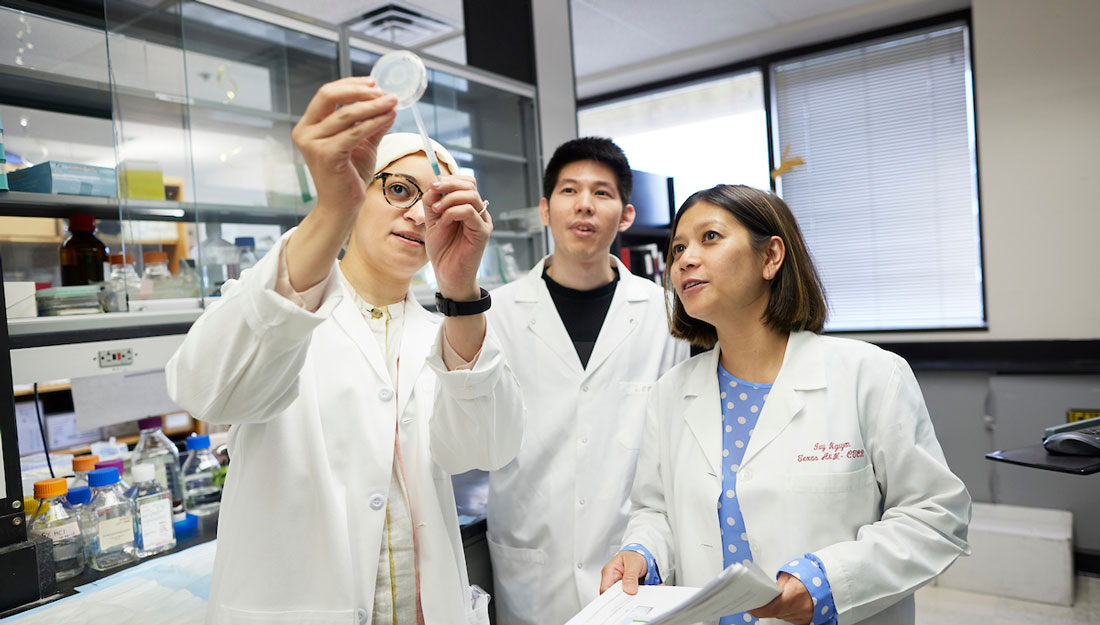- Christina Sumners
- Biosciences & Technology, Medicine, Research, Show on VR homepage
Understanding a lesser-known staph infection
Researchers from different Texas A&M campuses unite to investigate how Staphylococcus pseudintermedius causes infection

Dog and people in a park
There is a new staph infection to worry about. Staphylococcus pseudintermedius, unlike the human pathogen Staphylococcus aureus, infects mainly dogs. However, studies now show that S. pseudintermedius can adapt to humans and cause disease. Furthermore, just like the superbug methicillin-resistant S. aureus (MRSA), S. pseudintermedius can develop resistance to modern-day antibiotics.
To address this health concern, a team of scientists including Jon Skare, PhD, professor at the Texas A&M College of Medicine, Magnus Höök, PhD, Regents and Distinguished Professor at the Texas A&M Institute of Biosciences and Technology, and Sara Lawhon, DVM, PhD, associate professor at the Texas A&M College of Veterinary Medicine & Biomedical Sciences (CVM), are combining their expertise to investigate the biological mechanisms by which S. pseudintermedius causes disease in humans and in dogs.
The goal of the collaborative project (which made it to the final round of the X-Grant Competition this year) is to identify and characterize protein molecules that are involved in S. pseudintermedius-host interactions. The researchers explained this research is necessary to understand the molecular events important for the disease process and to target therapeutics—such as new antibiotics—that can combat S. pseudintermedius infections.
The team members said they all concurred that the incidence of S. pseudintermedius (including its methicillin-resistant variant) is vastly underestimated in human medicine because it is often misidentified as S. aureus. Routine biochemical tests often cannot discriminate between the two closely related strains. “So it’s possible that a person infected with a methicillin-susceptible S. aureus is actually infected with methicillin-resistant S. pseudintermedius, and this patient could receive the wrong therapy for a period of time,” Lawhon said.
Although closely related strains of bacteria, such as S. pseudintermedius and S. aureus, can have very similar structural properties, the underlying biological mechanisms by which a specific bacterium infects its host is distinctive. “The molecules that are involved are almost always unique,” Höök said. “There are some toxins that are shared, that are very similar in related bacterial species. But there isn’t a holy grail that you find.”
The three researchers work on different aspects of the project. Using DNA sequencing, Lawhon identifies proteins that might participate in the adhesion of S. pseudintermedius to the host’s skin. Skare conducts genetic screens to identify putative host proteins that can bind to S. pseudintermedius cell surface proteins, and Höök quantifies these interactions at a molecular level using biochemical tools.
According to the team, one of the main challenges of this project is establishing the right animal model to study the pathogenesis of S. pseudintermedius. Most laboratory animal models used are genetically similar and consequently, lack the diversity needed for genetic screening. Therefore, finding a suitable laboratory animal model in which the pathology of a S. pseudintermedius infection resembles that in its natural host is difficult.
To overcome this challenge, the researchers (in collaboration with Helene Andrews-Polymenis, DVM, PhD, and David Threadgill, PhD, both at the College of Medicine and the CVM, who were also a part of this X-Grant team) will use collaborative cross animal models—laboratory animal models that are engineered to have genetic diversity. In these animal models, the nature of the S. pseudintermedius infection will depend on the individual animal model’s genetic makeup. “The hope and goal is that we will be able to use the collaborative cross animal models to track the way S. pseudintermedius behaves more like what you see in its natural host,” Skare said.
The team also notes that the lessons learned from their research could be extended to research on other zoonotic diseases. “During the development of this program, we realized that the strategies we were using to understand why certain strains of bacteria can be transferred from the animal host to the human host or the strategies for using different animal models could be used for research on other pathogens as well,” Höök said. “The outcome of our research could also be common strategies for combating different types of infections.”
As is the case for an X-grant proposal, this project required the collaborative effort of many faculty members across Texas A&M University. Clinical samples from infected dogs were provided by Adam Patterson, DVM, and Aline Rodrigues-Hoffmann, DVM, PhD, both from the CVM. An organoid dog skin model system, utilized by Dominique Wiener, DVM, PhD, also from the CVM, is being adapted to test its utility for S. pseudintermedius infection. Additionally, Art Laganowsky, PhD, at the College of Science, who is instrumental in the protein characterization planned in this X-grant, is currently working with Lawhon and Höök to solve the 3D structure of a toxin produced by S. pseudintermedius.
Article written by Vandana Suresh
Media contact: media@tamu.edu


